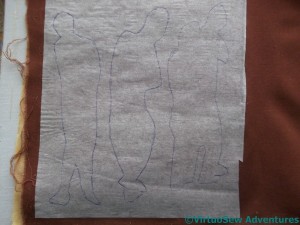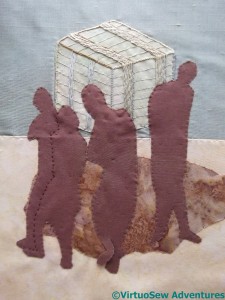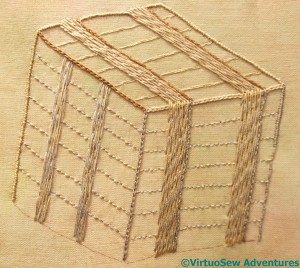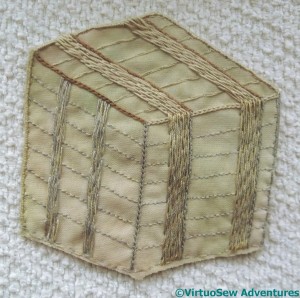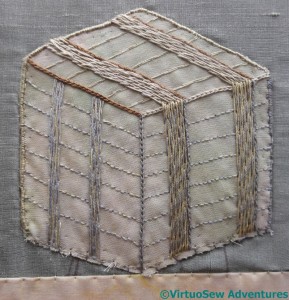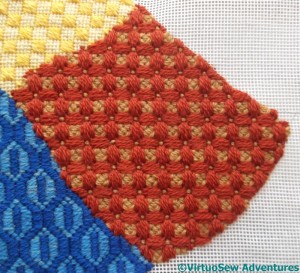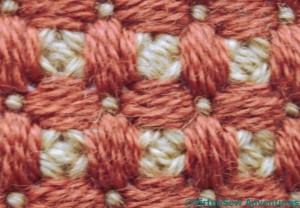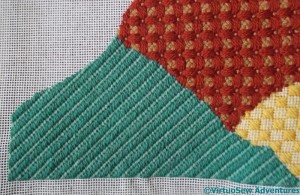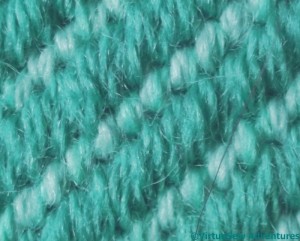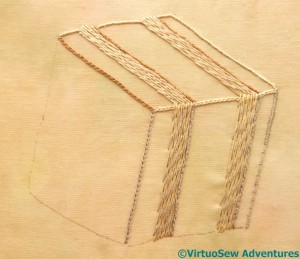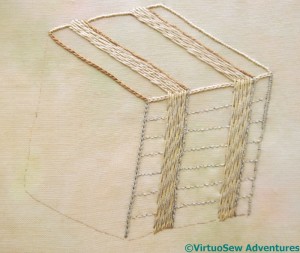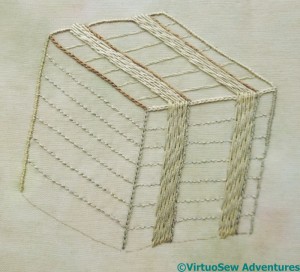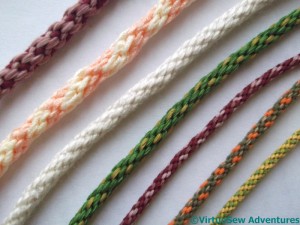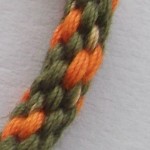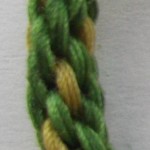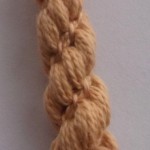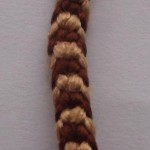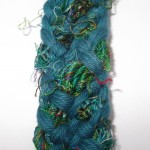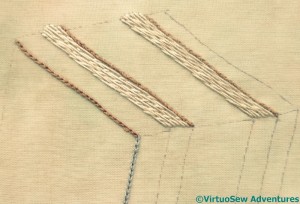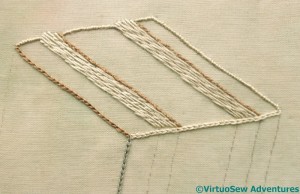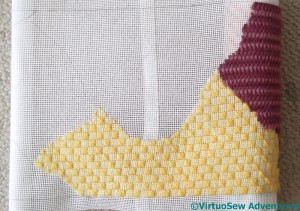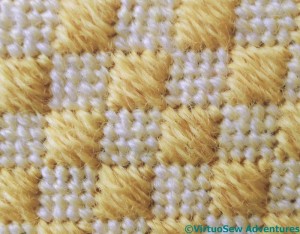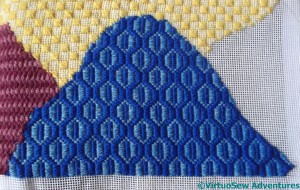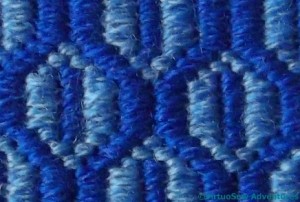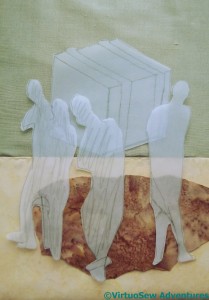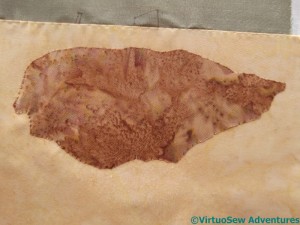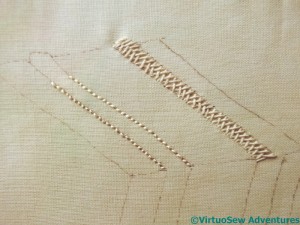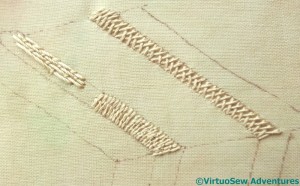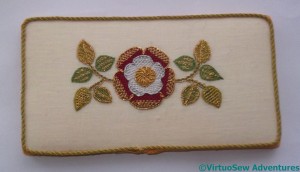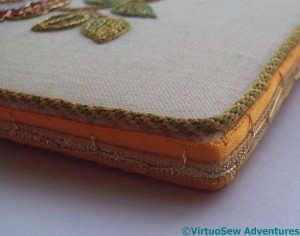About Rachel
View all posts by Rachel
Beginning the People
Once the packing case was in place it was time to put the people on. I’ve used iron-on transfer adhesive to stabilise the cotton fabric for the people. It isn’t likely that I will make use of the adhesive, but at least the tracing paper on the back allowed me to draw outlines of the people to cut out.
There was a brief pause while I made quite sure that I had traced the people the right way round to ensure that when I put them on, the fabric side would be uppermost and not the glue side, then I cut them out..
Attaching the people was fairly straightforward, using single strands of silk pulled from a bundle of odds and ends. I even tacked them in place with silk – which just shows how cavalier I have become since working with metal threads and Gilt Sylke Twist!
Very little of these cotton people will show once I’ve dressed them. They are there for two reasons – because I felt that it would be easier to do that dressing if I had some sense of the bodies beneath, and because I know from working on the Camberwell Panel that small bits are hard to place precisely, especially in conjunction with other small pieces. Since the people are inside their clothes, putting the heads and feet on last would put them out of kilter in comparison with everything else.
I have cut and left unattached one foot of one of the people because I need to put a trouser leg behind it, and roughly stitched a line between the two people I’ve cut out as a single piece of fabric. That should help me to ensure that when I dress the furthest of them, I don’t use more fabric than I need, or create a finished, turned edge that adds thickness where I don’t want it.
Now I need to stare thoughtfully at the photograph for a while and work out just how to approach the next stage.
Still that Packing Case
I’m rather afraid you’ll be fed up with this packing case. It’s caused me no end of thinking and re-thinking, stitching and re-stitching, but now I think I’ve done as much as can be done while it remains a separate piece. I may add more stitched details to the final piece, but that will be after I have everything else in place.
So the next job is to turn it into that separate piece which can then be attached in place on the background, and then itself become the background for the main adventure, which will be dressing the figures.
And here it is. I have left the fabric around the edges attached and folded it back to provide a little padding.
I’ve used single strands of stranded cotton to hold the extra fabric in place, and trimmed the unbound edges close.
None of the planks run quite true, but since the whole thing is a wild experiment that may go dreadfully wrong, I’m not going lose any sleep over that. If it looks wrong when it’s finished, I’ll unpick those bits and put them right. If it looks right in spite of wonky planks, I shall pretend it was meant to be that way..
Thank goodness I marked a couple of points to help me put the packing case in place. I double checked the placement with the tracing paper people, then went around the edges catching them down with small stitches and a sharp needle.
As far as possible, I stretched the packing case as I was attaching it. It puts the turban cotton under some slight strain, but with all the support underneath, I think it will be fine. I would be much more worried if this were to be applied to a garment…
Still More On The Packing Case
When I came to work the bands on the “back” surface of the packing case, I felt that the slightly darker yellow silk thread was still too bright, so I worked the Bokhara Couching in two colours – the yellow as the long stitch, and the grey as the diagonal couching stitch. That shadows it nicely, I think.
I’ve only worked the trailing satin stitch edging at the back for about twice the distance I think will be visible. I believe there will be enough layers of fabric over the top, representing the clothes of the figures, that the trail won’t show through – but there is no point making life too difficult!
I want to give some suggestion of the planks making up the packing case, but the silk thread is too heavy for that purpose. Fortunately I have some stranded threads that match the silk very closely, and using one of each colour breaks it up, as does using back stitches.
I used quilter’s disappearing pen to sketch approximate planks. It disappears so quickly that sometimes I’d lost my guideline by the time I was half way across!
I used a slightly different technique on the top. I’ve laid two strands across on each plank-line, and then couched down each strand individually in a brick pattern, It creates a less spotty effect, and I am now wondering whether I should take out the backstitch and use this other technique instead.
I’ve done the trailing satin stitch on the back edge, because I am fairly sure about that, but the planking still leaves me in a quandary. Have I used the right technique? Do I need to do more, to differentiate shadow from sunlit? Dare I leave it as it is, put it in place, and add any other details later?
So I am now, once again, at the “Stare at it and think” stage.
More Kumihimo
There were so many intrigued comments about my Marudai and the braids it made, that I thought I would show you some more of the braids I’ve made.
Kumihimo is a traditional Japanese technique. The braids have a lot of traditional uses in Japan – in fact, an opera singer friend of mine tells me his Samurai costume for his part in a brand-new opera about a crucial part of Japanese history was correct down to properly made kumihimo braids in all the right places!
If you search for Kumihimo on eBay, what you will find, by and large, are bracelets. Now, I’m really not a bracelet sort of girl. I have a few chunky, “statement” bangles, which are worn specifically, explicitly and only when I’m planning nothing more strenuous than lifting a knife and fork. Cord bracelets – no.
However, I do have a lot of heavy, dramatic pendants, and the idea of making cords to point up the colours in the pendants – yes, definitely. I’ve found that sewing machine thread makes a wonderful material for these purposes – it comes in a huge range of colours, and it’s fine, supple and strong. It also lends itself well to heathering – combining several colours in a single strand – and best of all, it’s relatively inexpensive.
The fine green and gold cord is silk, made using some of the thread from the Tudor Rose kit – I used it to trim the Tudor Rose panel.
The next three, and the top, chunky pinky-maroon, are all necklace cords made using sewing machine cotton, although the maroon mookaite pendant I made the two maroon ones for has spurned both of them with scorn. I’ll try again, because I enjoy kumihimo.
The white one is silk, to go with a pearl-mounted enamelled cross pendant given to me by an old family friend, and which I wore on my wedding day. The cord I used then has become grubby over the years, so this one will see me through a few more. The cream and peach usually carries a glass pendant. It’s one of two I’ve tried for that pendant, in fact – but this “making things match” is never quite as easy as we hope, is it!
The round apricot rope is huge – about for or five times the size of the other round cords I’ve done. I might mount it with cord ends and turn it into a choker one of these days..
The stripy one is a fairly fine flat braid in filament silk. I worked this one as an experiment, changing the tension (more or less weight on the end) to see what effect it would have. In the end I came to the conclusion I wasn’t being dramatic enough with my experiments!
These flat braids were given extra texture with saree silk knitting yarns. Again, they tell me that some of my experimentation needs to be a bit more dramatic. I was hoping to emphasize the different textures, but used too many strands of the cotton yarn, so there wasn’t enough difference between the strands.
There’s scope for endless experimentation here – and I haven’t shown you the miles of gold braid I’ve made…
More on the Packing Case
Having unpicked my experiments, I decided on a new approach..
Actually, a digression here. A lot of people talk of test-stitching, by which they mean trying something out, but not on the real thing. I did that with all those goldwork stitches in the Tudor and Stuart Goldwork Masterclass, but as a general rule, my experiments do happen on the project itself. As much as anything else, this is because it is the interaction between the fabric, the design, and the thread that I am experimenting with, and if I take one of those out, I’m not testing what I need to test. I have a picture in my mind of the effect I want to achieve, but it is rarely detailed enough for me to know what to do at every point before I even begin. Instead, I rely on the project to tell me what it wants next, and while some projects are sullen (they know who they are!) others are talkative beyond belief. This one, so far, occupies the middle ground!
End of digression.
Since I had decided on how I was going to work the reinforcing boards, I decided that it might – possibly! – make sense to work some of the dark shadows to help me with their edges. I’m using the warm brown as the dark edge on the top surface, to keep the sense of bright sunshine, and the greyish colour for the front surface which is in a more even shadow. I will be combining the grey and the yellow in the reinforcing boards to help confirm that effect.
I also need to make sure that all the edges are clear and won’t fray. A packing case holding delicate antiquities should be a solid looking object, not one suggesting that even a gentle tug will take it apart! Just to give that sense of solidity, I have worked an overcast trail along each of the top edges that will be cut, whereas the edges that are within the piece of fabric are worked in reverse chain stitch. So far..
More progress on Loading The Felucca
While I was working on the packing case, which is the first embellished section I will be applying, it occurred to me that for those occasions when the light was a little marginal (grey-ish yellow is a difficult colour to stitch in poor light!) I could perhaps prepare a layer that would be applied to provide the shadow on the ground.
I traced the approximate shape and used the tracing as a pattern piece. The fabric is – as are most of them – a cotton from one of the plethora of quilting and patchwork stands I visited during last year’s Harrogate Knitting and Stitching Show. The print gives a sort of scrunch-dyed effect that I thought might help to create the appearance of broken, shadowed ground.
Then I realised that placing it sensibly demanded that I bear in mind the other main pieces. I’ve cut out the tracing I used for the packing case, and the forms I intend to use for the people, and spent a bit of time juggling the positions of each element.
The people, by the way, are not supposed to proper people shaped from an artist’s model. Some of the shapes have extra legs, and one of them is two people blended into one. They will be differentiated by their clothing, or at least so I hope!
As it happens, attaching the shadow didn’t take as long as I expected. I decided that edging the fabric with blanket stitch would create a hard edge which would counteract the idea of the shadow going over broken ground. I may even choose to add stitching to break up the edges even more when the figures are in. I have learnt over the past few years not to overdo detail on one section of a piece like this until I have some sense of how the whole thing is going to turn out!
I am expecting to crop this piece very close, to concentrate attention on the figures and their burden, but I learnt with the Camberwell that it is easier to have some leeway around the edges of my project!
Loading the Felucca – starting on the packing case
Since appliqué is a layered technique, I had to work forwards from the most distant object. For this subject – once the background was in place, that was the packing case.
The first thing I had to do was to work out how I was going to represent the lengths of wood running as bracing all around the box. My first thought was to use reverse herringbone stitch, as I did for the contour lines on the Map of Amarna, but as I was stitching it I became less sure.
I worked the other band in ordinary herringbone stitch, then sat back and frowned at the frame for a while.
The result of my frowning cogitations was that I decided that I definitely didn’t like the reverse herringbone stitch, and wasn’t totally happy with the standard herringbone stitch either.
I tried variations on couching stitches – Bokhara Couching and Roumanian Couching, in the lower half of the nearer band – and was no happier.
Just as well I enjoy these puzzles, isn’t it!
Finally it occurred to me that the grain of the wood would be running lengthwise in these pieces of wood, while in the planks that make up the box, the grain would appear to run across the box. The stitching I had tried had given the impression of the grain running across the bracing struts. So I tried Bokhara Couching again, but running lengthwise.
That’s better, I think, but the next task is all that unpicking.
Tudor Rose Turned Into a Panel
At long last I got a chance to finish up and turn the Tudor Rose into a little mounted panel. I got a local framing shop to cut me two pieces of acid free mount board, and mounted it over one of them, with a little padding to bring it to life. Then I covered the other (also with wadding) with some upholstery fabric that happened to be to hand, and overstitched the two boards together.
I covered the overstitching with a ribbon trim left over from when I finally mounted Christus Natus Est (whoo-hoo, some stash busting achieved!) and then, at some length and not without difficulty, attached a fine kumihimo cord around the front edge of the panel to frame it nicely.
It will go in that famed (and so far, still mythological) Winter Decoration Corner that I keep on talking about – when I finally create it.

